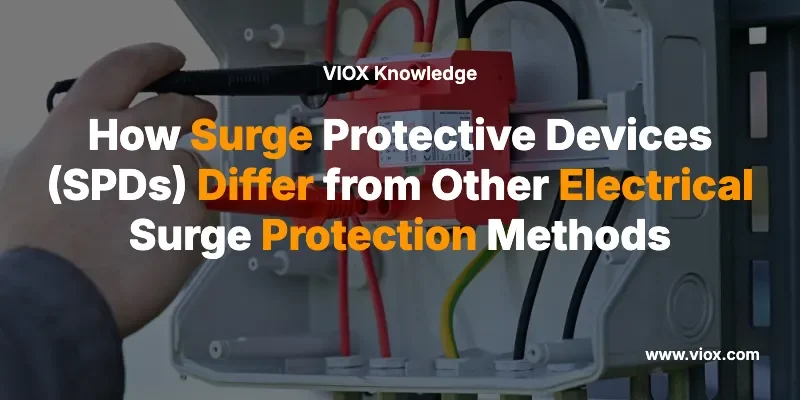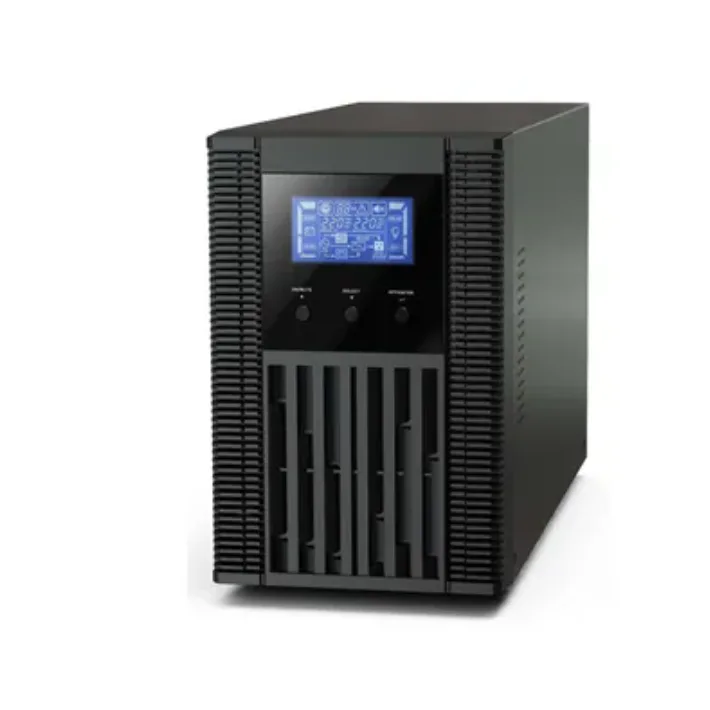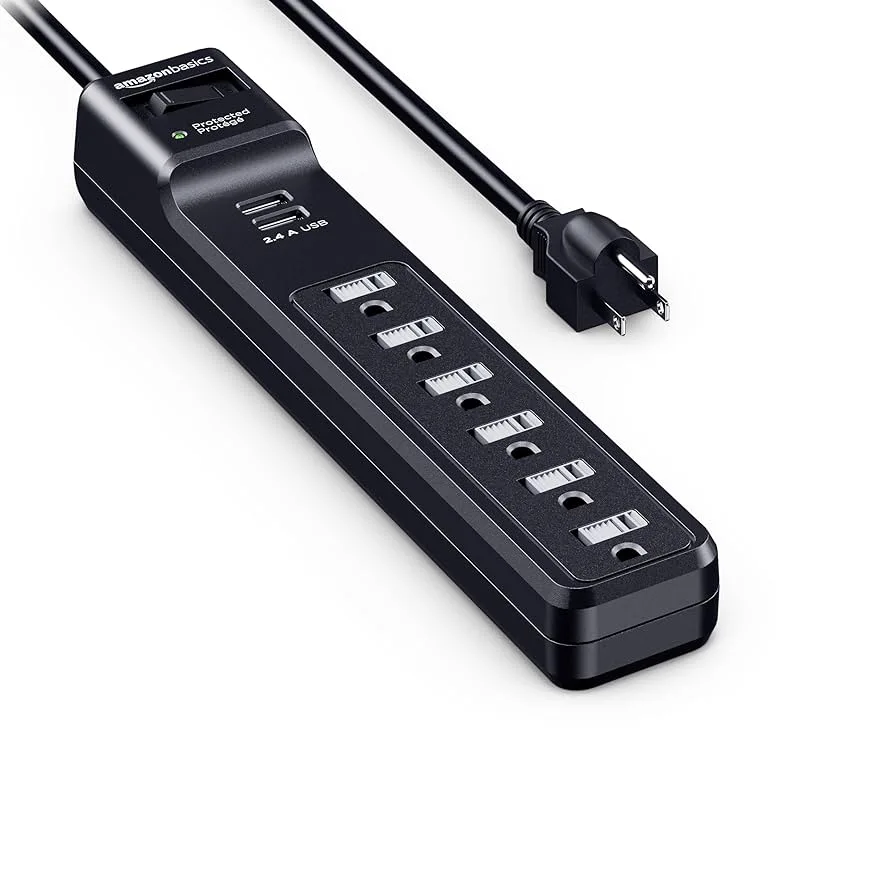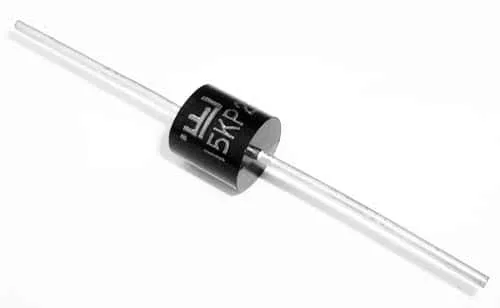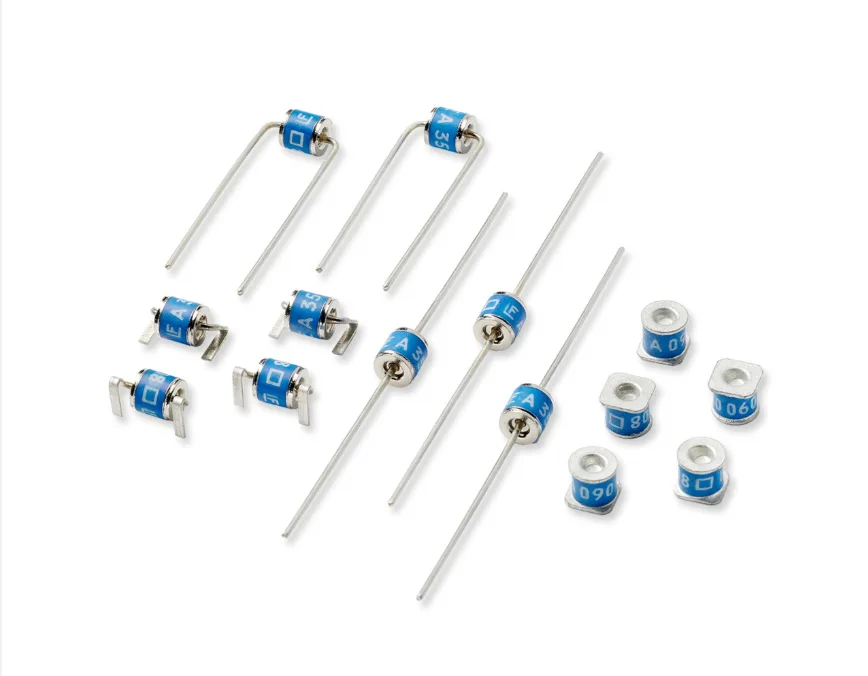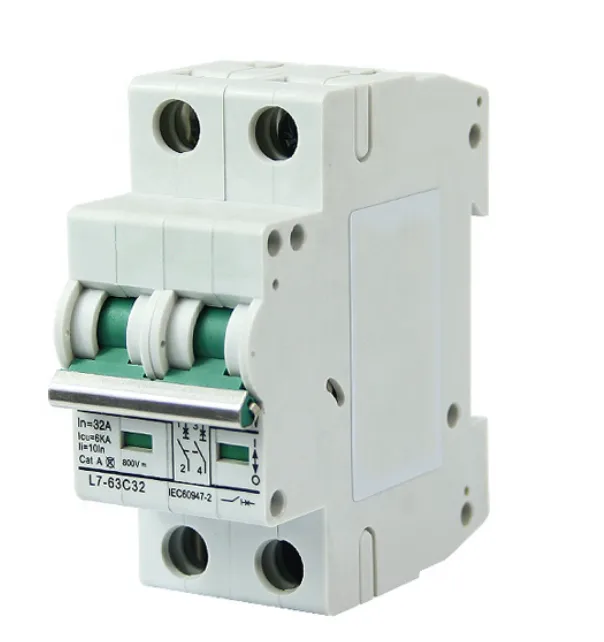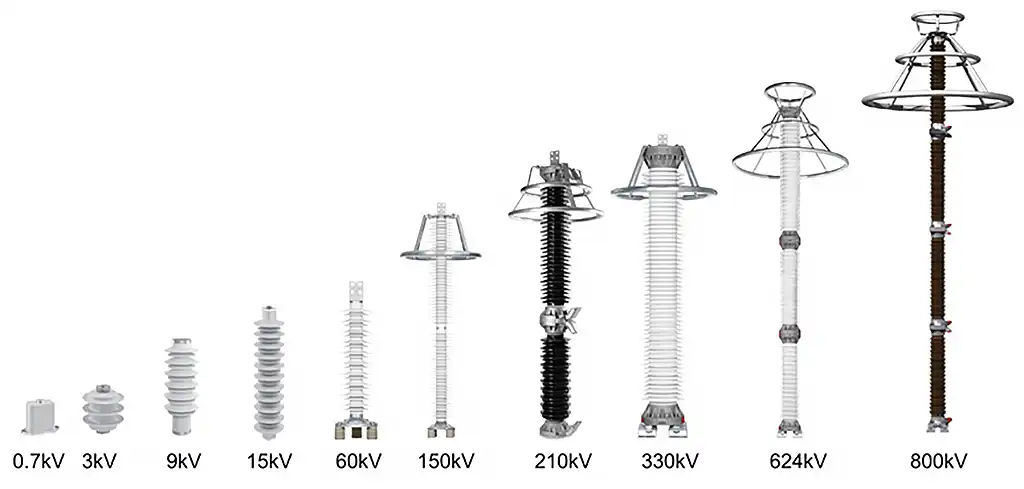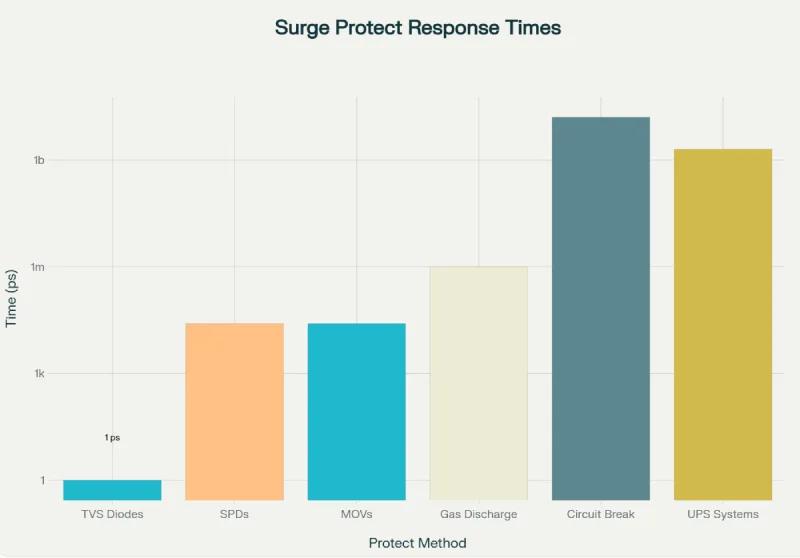ការយល់ដឹងអំពីឧបករណ៍ការពារការកើនឡើង (SPDs)
និយមន័យ និងមុខងារស្នូល
មួយ ឧបករណ៍ការពារការកើនឡើង (SPD) គឺជាឧបករណ៍ការពារសម្រាប់កំណត់វ៉ុលបណ្តោះអាសន្នដោយការបង្វែរ ឬកំណត់ចរន្តកើនឡើង ហើយមានសមត្ថភាពធ្វើមុខងារទាំងនេះឡើងវិញដូចដែលបានបញ្ជាក់។ SPDs ត្រូវបានគេស្គាល់ពីមុនថាជា Transient Voltage Surge Suppressors (TVSS) ឬឧបករណ៍ចាប់ការកើនឡើងបន្ទាប់បន្សំ (SSA) ប៉ុន្តែវាក្យស័ព្ទនេះត្រូវបានគេកំណត់ស្តង់ដារទៅជា SPD ជាមួយនឹងការអនុម័ត ANSI/UL 1449 លើកទី 3 ក្នុងឆ្នាំ 2009 ។
គោលការណ៍ជាមូលដ្ឋាននៅពីក្រោយ SPDs ពាក់ព័ន្ធនឹងការតភ្ជាប់ប៉ារ៉ាឡែលទៅនឹងសៀគ្វីផ្គត់ផ្គង់ថាមពលនៃបន្ទុកដែលពួកគេការពារ។ SPD ដែលភ្ជាប់ស្របគ្នាមាន impedance ខ្ពស់។ នៅពេលដែល overvoltage បណ្តោះអាសន្នលេចឡើងនៅក្នុងប្រព័ន្ធ impedance នៃឧបករណ៍ថយចុះ ដូច្នេះចរន្តកើនឡើងត្រូវបានជំរុញតាមរយៈ SPD ដោយឆ្លងកាត់ឧបករណ៍រសើប។
ប្រព័ន្ធចាត់ថ្នាក់ SPD
យោងតាមក្រមអគ្គិសនីជាតិ (NEC) និង ANSI/UL 1449 SPDs ត្រូវបានចាត់ថ្នាក់ជាបីប្រភេទសំខាន់ៗ ដោយផ្អែកលើទីតាំងដំឡើង និងកម្មវិធីដែលមានបំណង៖
ប្រភេទ 1 SPDs៖ ការការពារច្រកចូលសេវាកម្ម
ប្រភេទទី 1៖ ភ្ជាប់ជាអចិន្ត្រៃយ៍ ដែលមានបំណងសម្រាប់ការដំឡើងរវាងផ្នែកបន្ទាប់បន្សំនៃប្លែងសេវា និងផ្នែកខ្សែនៃសេវាកម្មផ្តាច់ឧបករណ៍ចរន្តលើស (ឧបករណ៍សេវាកម្ម)។ គោលបំណងចម្បងរបស់ពួកគេគឺដើម្បីការពារកម្រិតអ៊ីសូឡង់នៃប្រព័ន្ធអគ្គិសនីប្រឆាំងនឹងការកើនឡើងពីខាងក្រៅដែលបណ្តាលមកពីរន្ទះ ឬឧបករណ៍ប្រើប្រាស់កុងតាក់កុងតាក់ធនាគារ។
លក្ខណៈបច្ចេកទេសសំខាន់ៗ៖
- រលកបច្ចុប្បន្ន៖ 10/350 µs ចរន្ត Impulse
- ការគ្រប់គ្រងបច្ចុប្បន្ន: 50,000 ទៅ 200,000 អំពែរ
- ការដំឡើង៖ ឧបករណ៍ច្រកចូលសេវាកម្ម
- ការការពារបឋមប្រឆាំងនឹងរន្ទះដោយផ្ទាល់
ប្រភេទ 2 SPDs៖ ការការពារបន្ទះចែកចាយ
ប្រភេទទី 2៖ ភ្ជាប់ជាអចិន្ត្រៃយ៍ ដែលមានបំណងសម្រាប់ការដំឡើងនៅផ្នែកផ្ទុកនៃសេវាកម្ម ផ្តាច់ឧបករណ៍ចរន្តលើស (ឧបករណ៍សេវាកម្ម) រួមទាំងទីតាំងបន្ទះម៉ាក។ គោលបំណងចម្បងរបស់ពួកគេគឺដើម្បីការពារគ្រឿងអេឡិចត្រូនិចដែលងាយរងគ្រោះ និងបន្ទុកដែលមានមូលដ្ឋានលើ microprocessor ប្រឆាំងនឹងថាមពលរន្ទះដែលនៅសេសសល់ ការកើនឡើងដែលបង្កើតដោយម៉ូទ័រ និងព្រឹត្តិការណ៍កើនឡើងខាងក្នុងផ្សេងទៀត។
លក្ខណៈបច្ចេកទេសសំខាន់ៗ៖
- រលកបច្ចុប្បន្ន៖ ៨/២០ µs រលកបច្ចុប្បន្ន
- ការគ្រប់គ្រងបច្ចុប្បន្ន: 20,000 ទៅ 100,000 amperes
- ការដំឡើង៖ បន្ទះចែកចាយ និងមជ្ឈមណ្ឌលផ្ទុក
- ការការពារបឋមសម្រាប់ការសាងសង់ប្រព័ន្ធអគ្គិសនី
ប្រភេទ 3 SPDs៖ ការការពារចំណុចនៃការប្រើប្រាស់
ប្រភេទទី 3: ចំណុចនៃការប្រើប្រាស់ SPDs ត្រូវបានដំឡើងនៅប្រវែង conductor អប្បបរមា 10 ម៉ែត្រ (30 ហ្វីត) ពីបន្ទះសេវាអគ្គិសនីដល់ចំណុចនៃការប្រើប្រាស់។
លក្ខណៈបច្ចេកទេសសំខាន់ៗ៖
- រលកបច្ចុប្បន្ន៖ ការរួមបញ្ចូលគ្នា 1.2/50 μs វ៉ុល និង 8/20 μs បច្ចុប្បន្ន
- ការគ្រប់គ្រងបច្ចុប្បន្ន: 5,000 ទៅ 20,000 amperes
- ការដំឡើង៖ នៅជិតឧបករណ៍ការពារ
- ស្រទាប់ចុងក្រោយនៃការការពារដែលបានធ្វើមូលដ្ឋានីយកម្ម
វិធីសាស្រ្តការពារចរន្តអគ្គិសនីផ្សេងទៀត។
ប្រព័ន្ធផ្គត់ផ្គង់ថាមពលគ្មានការរំខាន (UPS)
ប្រព័ន្ធ UPS ផ្តល់នូវការការពារថាមពលដ៏ទូលំទូលាយដែលពង្រីកលើសពីការការពារការកើនឡើងធម្មតា។ ឧបករណ៍ទាំងនេះបន្តត្រួតពិនិត្យវ៉ុលចូល និងឆ្លើយតបទៅនឹងបញ្ហាគុណភាពថាមពលដោយប្តូរទៅថាមពលថ្មកំឡុងពេលដាច់ ឬការរំខានធ្ងន់ធ្ងរ។
លក្ខណៈការពារ UPS៖
– ឆ្លើយតបពេលវេលា: 2-10 មិល្លីវិនាទីសម្រាប់ការផ្ទេរថាមពល
– វិសាលភាពការពារ៖ កម្រិតឧបករណ៍បុគ្គល
– ការគ្រប់គ្រងបច្ចុប្បន្ន៖ អថេរផ្អែកលើសមត្ថភាពឯកតា
– មុខងារបន្ថែម៖ ការបម្រុងទុកថ្ម, ម៉ាស៊ីនត្រជាក់, បទប្បញ្ញត្តិវ៉ុល
– ចំណាយជួរ: $100-5,000+ អាស្រ័យលើសមត្ថភាព
ដែនកំណត់របស់ UPS សម្រាប់ការការពារការកើនឡើង៖
- ពេលវេលាឆ្លើយតបយឺតជាងបើប្រៀបធៀបទៅនឹង SPDs
- សមត្ថភាពគ្រប់គ្រងបច្ចុប្បន្នកើនឡើងមានកំណត់
- ទាមទារការថែទាំ និងប្តូរថ្ម
- មិនត្រូវបានរចនាឡើងសម្រាប់ការកើនឡើងនៃរន្ទះដែលមានថាមពលខ្ពស់។
Power Strip Protectors ទល់នឹង បន្ទះថាមពលមូលដ្ឋាន
បន្ទះថាមពលមូលដ្ឋាន
បន្ទះថាមពលគឺជាប្លុកនៃរន្ធអគ្គិសនីដែលអនុញ្ញាតឱ្យឧបករណ៍អគ្គិសនីជាច្រើនត្រូវបានផ្តល់ថាមពលពីព្រីអគ្គិសនីតែមួយ។ បន្ទះថាមពលមូលដ្ឋានមិនផ្តល់នូវការការពារការកើនឡើងទេ ទោះបីជាមានភាពស្រដៀងគ្នាដែលមើលឃើញទៅនឹងឧបករណ៍ការពារការកើនឡើងក៏ដោយ។
លក្ខណៈ៖
- មុខងារ៖ ចែកចាយថាមពលតែប៉ុណ្ណោះ
- ការការពារ៖ ឧបករណ៍បំបែកសៀគ្វីសម្រាប់តែការផ្ទុកលើសទម្ងន់ប៉ុណ្ណោះ។
- ពេលវេលាឆ្លើយតប៖ គ្មានសមត្ថភាពការពារការកើនឡើង
- តម្លៃ៖ $10-30
- កម្មវិធី៖ ឧបករណ៍មិនសំខាន់ដែលមិនត្រូវការការការពារការកើនឡើង
ច្រូតថាមពលការពារអ្នកប្រើប្រាស់
ភាពខុសគ្នាសំខាន់រវាងឧបករណ៍ការពារការកើនឡើង និងបន្ទះថាមពលគឺថាឧបករណ៍ការពារការកើនឡើងមានផ្ទុក MOV ។ MOV បង្វែរចរន្តអគ្គិសនីដែលបង្កគ្រោះថ្នាក់ចេញពីឧបករណ៍ដែលបានភ្ជាប់។
លក្ខណៈ៖
- ការគ្រប់គ្រងបច្ចុប្បន្ន: 1,000-4,000 joules ជាធម្មតា
- ពេលវេលាឆ្លើយតប៖ ២៥ ណាណូវិនាទី (MOV-based)
- វិសាលភាពការពារ៖ មានតែឧបករណ៍ដែលដោតដោយផ្ទាល់ទៅក្នុងបន្ទះប៉ុណ្ណោះ។
- វ៉ុលភ្ជាប់: 330-600 វ៉ុល
- Lifespan៖ ថយចុះជាមួយនឹងព្រឹត្តិការណ៍កើនឡើងនីមួយៗ
ឧបករណ៍បំលែងអុកស៊ីដលោហៈ (MOVs)
Metal Oxide Varistors គឺជារេស៊ីស្តង់ដែលពឹងផ្អែកលើវ៉ុលដែលបង្កើតជាបច្ចេកវិទ្យាស្នូលនៅក្នុងឧបករណ៍ការពារការកើនឡើងអ្នកប្រើប្រាស់ភាគច្រើន។ MOVs មានម៉ាទ្រីសសេរ៉ាមិចនៃគ្រាប់ធញ្ញជាតិអុកស៊ីដស័ង្កសីជាមួយនឹងព្រំដែនគ្រាប់ធញ្ញជាតិបង្កើតជាប្រសព្វ diode ។
ប្រតិបត្តិការ MOV៖
– លក្ខខណ្ឌធម្មតា។៖ ភាពធន់ខ្ពស់ជាមួយនឹងលំហូរចរន្តអប្បបរមា
– លក្ខខណ្ឌនៃការកើនឡើង៖ ការបំបែក Avalanche បង្កើតផ្លូវតស៊ូទាប
– ឆ្លើយតបពេលវេលា: 25 ណាណូវិនាទី
– ការគ្រប់គ្រងបច្ចុប្បន្ន: 1,000-20,000 amperes អាស្រ័យលើទំហំ
ដែនកំណត់ MOV៖
- ការរិចរិលរីកចម្រើនជាមួយនឹងការប៉ះពាល់នឹងការកើនឡើងម្តងហើយម្តងទៀត
- ជាយថាហេតុតម្រូវឱ្យមានការជំនួសបន្ទាប់ពីការដោះស្រាយការកើនឡើងជាច្រើន។
- គ្មានការចង្អុលបង្ហាញអំពីស្ថានភាពការពារនៅក្នុងការអនុវត្តជាមូលដ្ឋាន
Diodes ការទប់ស្កាត់វ៉ុលបណ្តោះអាសន្ន (TVS)
TVS diodes គឺជា diodes avalanche ឯកទេសដែលត្រូវបានរចនាឡើងសម្រាប់ការការពារការកើនឡើងលឿនបំផុតនៅក្នុងគ្រឿងអេឡិចត្រូនិចដែលងាយរងគ្រោះ។
លក្ខណៈពិសេស TVS Diode:
– ឆ្លើយតបពេលវេលា: 1 picosecond (មានល្បឿនលឿនបំផុត)
– ការគ្រប់គ្រងបច្ចុប្បន្ន: ជីពចរកំពូល 10,000-30,000 amperes
– ភាពជាក់លាក់នៃវ៉ុល៖ កម្រិតនៃការតោងយ៉ាងជាក់លាក់
– អាយុកាល: មិនមានផលប៉ះពាល់នៃភាពចាស់, ស្ថេរភាពរយៈពេលវែងល្អឥតខ្ចោះ
– កម្មវិធី៖ ការការពារកម្រិត PCB នៅក្នុងឧបករណ៍អេឡិចត្រូនិក
គុណសម្បត្តិជាង MOVs៖
- មិនមានការរិចរិលតាមពេលវេលា
- ការឆ្លើយតបលឿនបំផុតសម្រាប់ការការពារ ESD
- លក្ខណៈនៃការតោងវ៉ុលច្បាស់លាស់
- ប្រតិបត្តិការដែលអាចទុកចិត្តបានលើអាយុកាលឧបករណ៍
បំពង់បង្ហូរឧស្ម័ន (GDTs)
បំពង់បង្ហូរឧស្ម័នមានមុខងារជាកុងតាក់គ្រប់គ្រងវ៉ុល ដោយប្រើគោលការណ៍បញ្ចេញឧស្ម័នអសកម្ម ដែលប្រើជាទូទៅក្នុងឧបករណ៍ទូរគមនាគមន៍។
លក្ខណៈពិសេសរបស់ GDT
– ឆ្លើយតបពេលវេលា៖ <1 មីក្រូវិនាទី
– ការគ្រប់គ្រងបច្ចុប្បន្ន: 10,000-40,000 អំពែរ
– រដ្ឋធម្មតា។៖ impedance ខ្ពស់ណាស់ capacitance អប្បបរមា
– រដ្ឋដែលបានធ្វើឱ្យសកម្ម: ផ្លូវបញ្ជូន impedance ទាប
– កម្មវិធី៖ ទូរគមនាគមន៍ ការការពារតង់ស្យុងខ្ពស់។
ឧបករណ៍បំបែកសៀគ្វី និងការការពារសុវត្ថិភាព
ឧបករណ៍បំបែកសៀគ្វីប្រពៃណី
ឧបករណ៍បំបែកសៀគ្វីផ្តល់នូវការការពារចរន្តលើស ប៉ុន្តែមិនត្រូវបានរចនាឡើងសម្រាប់ការការពារការកើនឡើងនោះទេ។
លក្ខណៈបច្ចេកទេសរបស់ឧបករណ៍បំបែកសៀគ្វី៖
– មុខងារ៖ ការការពារចរន្តលើស និងសៀគ្វីខ្លី
– ឆ្លើយតបពេលវេលា: 16-100 មីលីវិនាទី
– ការការពាររលក៖ គ្មាន (យឺតពេកសម្រាប់ការកើនឡើងវ៉ុល)
– ការគ្រប់គ្រងបច្ចុប្បន្ន៖ វាយតម្លៃ amperage សម្រាប់ប្រតិបត្តិការបន្ត
– កម្មវិធី៖ ការការពារសៀគ្វីអគ្គីសនីទូទៅ
GFCI និងការការពារ AFCI
– GFCI៖ ការការពារកំហុសដី (ភាពប្រែប្រួល 5 mA, ការឆ្លើយតប 25-30 ms)
– AFCI៖ ការការពារកំហុសធ្នូសម្រាប់ការពារភ្លើង
– មុខងារ៖ ការការពារសុវត្ថិភាព មិនមែនការការពារការកើនឡើង
– តម្រូវការ៖ កំណត់ដោយ គ.ជ.ប នៅទីតាំងជាក់លាក់
ប្រព័ន្ធការពាររន្ទះ
អ្នកចាប់ខ្លួនរន្ទះ
ឧបករណ៍ចាប់រន្ទះការពារប្រព័ន្ធបញ្ជូន និងចែកចាយពីការវាយលុកនៃរន្ទះដោយផ្ទាល់ និងការប្តូរអន្តរកាល។
លក្ខណៈពិសេសនៃការចាប់ខ្លួនរន្ទះ៖
– ការគ្រប់គ្រងបច្ចុប្បន្ន៖ 100,000+ អំពែរ
– កម្រិតវ៉ុល: វ៉ុលប្រព័ន្ធបញ្ជូន (> 1000V)
– ឆ្លើយតបពេលវេលា៖ មីក្រូវិនាទី
– កម្មវិធី៖ ប្រព័ន្ធបញ្ជូន និងចែកចាយឧបករណ៍ប្រើប្រាស់
– ការចំណាយ៖ $1,000-10,000+ សម្រាប់ឧបករណ៍ថ្នាក់បញ្ជូន
Lightning Rods (ស្ថានីយអាកាស)
– មុខងារ៖ ផ្តល់ផ្លូវផ្លេកបន្ទោរដែលពេញចិត្ត
– ការការពារ៖ ការការពាររចនាសម្ព័ន្ធសំណង់
– សមាហរណកម្ម៖ ធ្វើការជាមួយប្រព័ន្ធដី
– ការគ្រប់គ្រងបច្ចុប្បន្ន: ចរន្តផ្លេកបន្ទោរពេញ (រហូតដល់ 200,000 អំពែរ)
គុណភាពថាមពល និងបរិក្ខារម៉ាស៊ីនត្រជាក់
និយតករវ៉ុលនិងស្ថេរភាព
ម៉ាស៊ីនត្រជាក់ផ្តោតលើគុណភាពថាមពលមានស្ថិរភាព ជាជាងការការពារការកើនឡើងបណ្តោះអាសន្ន។
លក្ខណៈបទប្បញ្ញត្តិវ៉ុល៖
– មុខងារ៖ រក្សាកម្រិតវ៉ុលជាប់លាប់ (± 1-5%)
– ឆ្លើយតបពេលវេលា៖ មិល្លីវិនាទីសម្រាប់ការកែតម្រូវវ៉ុល
– ប្រភេទការពារ៖ ការការពារការដាច់ភ្លើង និងវ៉ុលលើស
– កម្មវិធី៖ តំបន់ដែលមានគុណភាពថាមពលប្រើប្រាស់ខ្សោយ
– ការចំណាយ: $100-1,000+ អាស្រ័យលើសមត្ថភាព
ឧបករណ៍បំលែងឯកោ
– មុខងារ៖ ការដាច់ចរន្តអគ្គិសនី និងការកាត់បន្ថយការកើនឡើង
– ការការពារ៖ ការបន្ថយល្បឿនក្នុងរបៀបទូទៅ (-60dB ឬល្អជាង)
– ការគ្រប់គ្រងវ៉ុល: 30kV Impulse input, 10kV output (ធម្មតា)
– កម្មវិធី៖ ឧបករណ៍វេជ្ជសាស្ត្រ ឧបករណ៍រសើប
តម្រងខ្សែថាមពល និងការការពារ EMI
– មុខងារ៖ ចម្រោះការជ្រៀតជ្រែកអេឡិចត្រូម៉ាញ៉េទិច និងសំឡេងអគ្គិសនី
– ប្រតិបត្តិការ៖ តម្រងបន្តនៃ EMI/RFI ដែលបានធ្វើឡើង
– សមាសធាតុ: អាំងឌុចទ័រ, capacitors, ស្នូល ferrite
– វិសាលភាព៖ បំពេញបន្ថែមការការពារការកើនឡើង កុំជំនួសវា។
SPDs ធៀបនឹងវិធីសាស្ត្រការពារចរន្តអគ្គិសនីផ្សេងទៀត។
| វិធីសាស្រ្ត | មុខងារ | ការឆ្លើយតប | ទីតាំង | បច្ចុប្បន្ន | វ៉ុល | អាយុកាល | ការចំណាយ | កម្មវិធី |
|---|---|---|---|---|---|---|---|---|
| SPD ប្រភេទ 1 | ផ្លេកបន្ទោរ | ២៥ ន | ការបញ្ចូលសេវាកម្ម | 50-200 kA | 700-1500V | ភាពធន់ខ្ពស់។ | ខ្ពស់។ | បន្ទះសេវាកម្ម |
| SPD ប្រភេទ 2 | ការចែកចាយ | ២៥ ន | ការចែកចាយ | 20-100 kA | 600-1200V | ភាពធន់ខ្ពស់។ | មធ្យម | ខាគ្វី |
| SPD ប្រភេទ 3 | ចំណុចនៃការប្រើប្រាស់ | ២៥ ន | នៅជិតឧបករណ៍ | 5-20 kA | 330-600V | ភាពធន់មធ្យម | ទាប | អេឡិចត្រិច |
| ប្រព័ន្ធ UPS | ការបម្រុងទុកថាមពល | 2-10 ms | ឧបករណ៍ lvl | អថេរ | ± 3-5% | ថ្មអាស្រ័យ | ខ្ពស់។ | ឧបករណ៍សំខាន់ |
| ឧបករណ៍បំបែកសៀគ្វី | ចរន្តលើស | 16-100 ms | ការចែកចាយ | អថេរ | គ្មាន | ខ្ពស់ណាស់។ | ទាប | សៀគ្វីទូទៅ |
| ម៉ូវ | ការគៀបវ៉ុល | ២៥ ន | កម្រិតឧបករណ៍ | 1-20 kA | អថេរ | អន់ថយ | ទាបណាស់។ | សមាសធាតុ prot |
| TVS Diodes | អន្តរកាលលឿន | 1 ទំ | កម្រិត PCB | 10-30 kA | ច្បាស់លាស់ណាស់។ | គ្មានភាពចាស់ | ទាប | អេឡិចត្រូនិច |
| ការបញ្ចេញឧស្ម័ន | តង់ស្យុងខ្ពស់។ | <1 µs | ឧបករណ៍ lvl | 10-40 kA | តង់ស្យុងខ្ពស់។ | ខ្ពស់ណាស់។ | មធ្យម | ទូរគមនាគមន៍ |
| ការចាប់ខ្លួនរន្ទះ | រន្ទះបាញ់ | Microseconds | ការឆ្លង | 100+ kA | កម្រិត kV | ខ្ពស់ណាស់។ | ខ្ពស់។ | ប្រព័ន្ធថាមពល |
| លក្ខខណ្ឌថាមពល | គុណភាពថាមពល | បន្ត | ឧបករណ៍ lvl | ការផ្ទុកអាស្រ័យលើ | ± 5-10% | ខ្ពស់។ | ខ្ពស់។ | ឧបករណ៍រសើប |
| ភាពឯកោ Trans | អ៊ីសូឡង់អគ្គិសនី | បន្ត | ឧបករណ៍ lvl | ការផ្ទុកអាស្រ័យលើ | ភាពឯកោល្អ។ | ខ្ពស់ណាស់។ | ខ្ពស់។ | បរិក្ខារពេទ្យ |
ការប្រៀបធៀបដ៏ទូលំទូលាយ៖ SPDs ធៀបនឹងវិធីសាស្ត្រការពារផ្សេងទៀត។
ការវិភាគពេលវេលាឆ្លើយតប
ការការពារលឿនបំផុត (Picoseconds)៖
- TVS Diodes: 1 picosecond - ល្អសម្រាប់ ESD និង transients លឿន
ការការពាររហ័ស (ណាណូវិនាទី)៖
- SPDs (គ្រប់ប្រភេទ)៖ 25 nanoseconds - ល្អឥតខ្ចោះសម្រាប់ការកើនឡើងវ៉ុល
– MOVs: 25 nanoseconds – ល្អសម្រាប់ការកើនឡើងកម្រិតមធ្យម
ល្បឿនមធ្យម (មីក្រូវិនាទី)៖
- បំពង់បង្ហូរឧស្ម័ន៖ <1 មីក្រូវិនាទី - ស័ក្តិសមសម្រាប់ព្រឹត្តិការណ៍ដែលមានថាមពលខ្ពស់។
ការឆ្លើយតបយឺត (មីលីវិនាទី)៖
- ប្រព័ន្ធ UPS: 2-10 មិល្លីវិនាទី - គ្រប់គ្រាន់សម្រាប់ការផ្ទេរថាមពល
- GFCI/AFCI: 25-30 មិល្លីវិនាទី - កម្មវិធីផ្តោតលើសុវត្ថិភាព
- ឧបករណ៍បំបែកសៀគ្វីៈ 16-100 មិល្លីវិនាទី - ការការពារចរន្តលើសតែប៉ុណ្ណោះ
ការប្រៀបធៀបសមត្ថភាពគ្រប់គ្រងបច្ចុប្បន្ន
ថាមពលខ្ពស់បំផុត (100+ kA)៖
- ឧបករណ៍ចាប់រន្ទះ៖ ការការពារកម្រិតបញ្ជូន
- SPD ប្រភេទ 1: 50-200 kA ការការពារច្រកចូលសេវាកម្ម
ថាមពលខ្ពស់ (20-100 kA):
- SPD ប្រភេទ 2: 20-100 kA ការការពារការចែកចាយ
- បំពង់បង្ហូរឧស្ម័ន៖ ការការពារទូរគមនាគមន៍ 10-40 kA
ថាមពលមធ្យម (5-30 kA):
- SPD ប្រភេទ 3: 5-20 kA ការការពារចំណុចនៃការប្រើប្រាស់
- TVS Diodes: ការការពារអេឡិចត្រូនិចជាក់លាក់ 10-30 kA
ថាមពលមានកំណត់ (1-20 kA)៖
- ការការពារការកើនឡើងអ្នកប្រើប្រាស់៖ ការការពារឧបករណ៍ 1-4 kA
- MOVs៖ ការការពារសមាសធាតុ 1-20 kA
គ្មានការការពាររលក៖
- បន្ទះថាមពលមូលដ្ឋាន៖ វាយតម្លៃឧបករណ៍បំប្លែងសៀគ្វីតែប៉ុណ្ណោះ
- ឧបករណ៍បំប្លែងសៀគ្វី៖ ការការពារចរន្តលើស, មិនមានការគ្រប់គ្រងការកើនឡើង
ទីតាំងដំឡើង និងការរួមបញ្ចូលប្រព័ន្ធ
ការដំឡើង SPD តាមឋានានុក្រម
SPDs អនុវត្តតាមវិធីសាស្រ្តនៃការដំឡើងជាប្រព័ន្ធដែលផ្តល់នូវការការពារសម្របសម្រួល៖
1. ប្រភេទ 1 SPDsច្រកចូលសេវាកម្ម - ខ្សែការពារទីមួយ
2. ប្រភេទ 2 SPDs៖ បន្ទះចែកចាយ - ការការពារអគារសំខាន់
3. ប្រភេទ 3 SPDs៖ ចំណុចនៃការប្រើប្រាស់ - ការការពារឧបករណ៍ចុងក្រោយ
ការដំឡើងវិធីសាស្រ្តផ្សេងទៀត។
– ប្រព័ន្ធ UPS៖ កម្រិតបរិក្ខារ ទាមទារការតភ្ជាប់បន្ទុក
– អ្នកការពារការកើនឡើងអ្នកប្រើប្រាស់៖ កម្រិតឧបករណ៍, ចល័ត
– ការការពារសៀគ្វី៖ បន្ទះចែកចាយ ផ្តោតលើសុវត្ថិភាព
– ការការពារសមាសធាតុ: កម្រិត PCB ឬនៅក្នុងឧបករណ៍
– ឧបករណ៍គុណភាពថាមពល៖ កម្រិតបរិក្ខារ កម្មវិធីជាក់លាក់
ការអនុលោមតាមស្តង់ដារ និងបទប្បញ្ញត្តិ
ក្របខ័ណ្ឌស្តង់ដារ SPD
– ANSI/UL 1449៖ ស្តង់ដារ SPD អាមេរិកខាងជើងបឋម
– ស៊េរី IEC 61643៖ ស្តង់ដារ SPD អន្តរជាតិ
– គ.ជ.ប មាត្រា ២៨៥៖ តម្រូវការដំឡើងសម្រាប់ SPDs
– តម្រូវការចាំបាច់៖ NEC 2020+ ទាមទារ SPDs សម្រាប់លំនៅដ្ឋាន
ស្តង់ដារវិធីសាស្រ្តផ្សេងទៀត។
– ប្រព័ន្ធ UPS: UL 1778, IEC 62040 ស៊េរី
– ឧបករណ៍បំបែកសៀគ្វី: UL 489, IEC 60947 ស៊េរី
– អ្នកការពារការកើនឡើងអ្នកប្រើប្រាស់: UL 1449 (ការចាត់ថ្នាក់ប្រភេទទី 3)
– ការការពារសមាសធាតុ៖ បទដ្ឋានជាក់លាក់នៃសមាសធាតុផ្សេងៗ
ការពិចារណាផ្នែកសេដ្ឋកិច្ច និងជាក់ស្តែង
ការវិភាគតម្លៃ-អត្ថប្រយោជន៍
អត្ថប្រយោជន៍នៃការវិនិយោគ SPD៖
- ការការពារប្រព័ន្ធទាំងមូលធៀបនឹងការចំណាយលើឧបករណ៍ដោយឧបករណ៍
- អាយុកាលប្រតិបត្តិការយូរជាមួយនឹងការថែទាំតិចតួចបំផុត។
- ការអនុលោមតាមបទប្បញ្ញត្តិជាមួយនឹងការដំឡើងតែមួយ
- ការការពារខ្សែភ្លើងក្នុងអគារ និងឧបករណ៍ដែលភ្ជាប់មកជាមួយ
តម្លៃសរុបនៃកម្មសិទ្ធិ៖
– ប្រភេទ 2 SPD៖ ការដំឡើង $200-800 បូកការពារផ្ទះទាំងមូល
– ឧបករណ៍ការពារការកើនឡើងអ្នកប្រើប្រាស់ច្រើន។៖ $20-100 នីមួយៗ ត្រូវការច្រើនគ្រឿង
– ប្រព័ន្ធ UPS៖ $100-5,000+ បូកនឹងថ្លៃជំនួសថ្ម
– ការខូចខាតដោយរលក៖ រោងចក្រឧស្សាហកម្មជាមធ្យមខាតបង់ $39 ពាន់លានជារៀងរាល់ឆ្នាំ
តម្រូវការថែទាំ
ការថែទាំទាប៖
- SPDs៖ ការត្រួតពិនិត្យស្ថានភាព ការត្រួតពិនិត្យតាមកាលកំណត់
- TVS Diodes៖ មិនត្រូវការការថែទាំទេ។
- ឧបករណ៍បំបែកសៀគ្វី៖ ការធ្វើតេស្តតាមកាលកំណត់
ការថែទាំខ្ពស់៖
- ប្រព័ន្ធ UPS៖ ប្តូរថ្មរៀងរាល់ 3-5 ឆ្នាំម្តង
- MOVs: ការជំនួសបន្ទាប់ពីការរិចរិល
- ម៉ាស៊ីនត្រជាក់៖ ការជំនួសតម្រង ការក្រិតតាមខ្នាត
ការណែនាំអំពីកម្មវិធីជាក់លាក់
កម្មវិធីលំនៅដ្ឋាន
ការការពារបឋម៖ ប្រភេទ 2 SPD នៅបន្ទះមេ (គ.ជ.ប តម្រូវឱ្យ 2020+)
ការការពារបន្ទាប់បន្សំ៖ ប្រភេទ 3 SPDs សម្រាប់អេឡិចត្រូនិចដែលងាយរងគ្រោះ
ថាមពលបម្រុងទុក៖ UPS សម្រាប់ឧបករណ៍សំខាន់ៗ (កុំព្យូទ័រ ឧបករណ៍វេជ្ជសាស្ត្រ)
កម្មវិធីពាណិជ្ជកម្ម និងឧស្សាហកម្ម
ការការពារបឋម៖ ប្រភេទ 1 ឬ 2 SPDs នៅច្រកចូលសេវាកម្ម
ការការពារការចែកចាយ៖ វាយ 2 SPDs នៅបន្ទះរង
ការការពារឧបករណ៍៖ ប្រភេទ 3 SPDs និង UPS សម្រាប់ប្រព័ន្ធសំខាន់ៗ
ការការពារពិសេស៖ ម៉ាស៊ីនត្រជាក់សម្រាប់ដំណើរការរសើប
ទូរគមនាគមន៍ និងមជ្ឈមណ្ឌលទិន្នន័យ
ការការពារ AC៖ ការដំឡើង SPD ដែលបានសម្របសម្រួល (ប្រភេទ 1, 2, 3)
ការការពារ DC៖ SPDs ឯកទេសសម្រាប់ខ្សែទូរគមនាគមន៍
ទិន្នន័យល្បឿនលឿន៖ TVS diodes សម្រាប់ការការពារខ្សែសញ្ញា
ប្រព័ន្ធសំខាន់៖ UPS ជាមួយនឹងការបម្រុងទុកថ្មសម្រាប់ប្រតិបត្តិការគ្មានការរំខាន
សេចក្តីសង្ខេបនៃភាពខុសគ្នាសំខាន់ៗ
SPDs ធៀបនឹងអ្នកការពារការកើនឡើងអ្នកប្រើប្រាស់
– ការគ្រប់គ្រងថាមពល៖ SPDs គ្រប់គ្រង 20-200 kA ទល់នឹង 1-4 kA សម្រាប់គ្រឿងប្រើប្រាស់
– វិសាលភាពការពារ៖ ប្រព័ន្ធទាំងមូលធៀបនឹងការការពារឧបករណ៍បុគ្គល
– ការដំឡើង៖ ការម៉ោនបន្ទះអចិន្រ្តៃយ៍ធៀបនឹងកម្មវិធីជំនួយចល័ត
– ស្តង់ដារ៖ ស្តង់ដារអគ្គិសនីវិជ្ជាជីវៈធៀបនឹងស្តង់ដារផលិតផលប្រើប្រាស់
– អាយុជីវិត៖ រចនាឡើងសម្រាប់ជីវិតសេវាកម្មដ៏វែងធៀបនឹងការជំនួសបន្ទាប់ពីការកើនឡើងធំៗ
SPDs ទល់នឹង UPS Systems
– មុខងារចម្បង៖ ការការពារការកើនឡើងធៀបនឹងការបម្រុងទុកថាមពល
– ពេលវេលាឆ្លើយតប៖ 25 ណាណូវិនាទីធៀបនឹង 2-10 មិល្លីវិនាទី
– ការគ្រប់គ្រងថាមពល៖ ចរន្តកើនឡើងខ្ពស់ធៀបនឹងការការពារការកើនឡើងមានកំណត់
– ថែទាំ៖ អប្បបរមាធៀបនឹងការជំនួសថ្មដែលត្រូវការ
– តម្លៃ៖ ការដំឡើងតែម្តងទល់នឹងតម្លៃថ្មដែលកំពុងដំណើរការ
SPDs ធៀបនឹងឧបករណ៍គុណភាពថាមពល
– ប្រភេទការពារ៖ ការការពារការកើនឡើងបណ្តោះអាសន្នធៀបនឹងគុណភាពថាមពលដែលមានស្ថិរភាព
– ល្បឿនឆ្លើយតប៖ ណាណូវិនាទីធៀបនឹងមីលីវិនាទី
– កម្មវិធី៖ ព្រឹត្តិការណ៍កើនឡើងធៀបនឹងការកំណត់ថាមពលបន្ត
– ការដំឡើង៖ ការតភ្ជាប់ប៉ារ៉ាឡែលទល់នឹងការដំឡើងស៊េរី
សេចក្តីសន្និ
ឧបករណ៍ការពារការកើនឡើង តំណាងឱ្យវិធីសាស្រ្តឯកទេស និងមានប្រសិទ្ធភាពខ្ពស់ចំពោះការការពារការកើនឡើងអគ្គិសនី ដែលខុសគ្នាជាមូលដ្ឋានពីវិធីសាស្ត្រការពារផ្សេងទៀតនៅក្នុងកម្មវិធីជាប្រព័ន្ធ ការអនុលោមតាមបទប្បញ្ញត្តិ និងសមត្ថភាពការពារដ៏ទូលំទូលាយរបស់ពួកគេ។ ខណៈពេលដែលវិធីសាស្រ្តផ្សេងទៀតដូចជាប្រព័ន្ធ UPS, ឧបករណ៍បំបែកសៀគ្វី, MOVs, diodes TVS និងម៉ាស៊ីនត្រជាក់នីមួយៗមានតួនាទីសំខាន់ក្នុងការការពារអគ្គិសនី SPDs ផ្តល់នូវអត្ថប្រយោជន៍ពិសេសតាមរយៈរបស់ពួកគេ៖
– ប្រព័ន្ធចំណាត់ថ្នាក់ស្តង់ដារ (ប្រភេទ 1, 2, 3) សម្រាប់ការការពារដោយសំរបសំរួល
– ពេលវេលាឆ្លើយតបរហ័ស (25 nanoseconds) សម្រាប់ការគៀបការកើនឡើងប្រកបដោយប្រសិទ្ធភាព
– សមត្ថភាពគ្រប់គ្រងបច្ចុប្បន្នខ្ពស់។ (20,000-200,000 amperes) សម្រាប់ព្រឹត្តិការណ៍កើនឡើងធ្ងន់ធ្ងរ
– ក្របខ័ណ្ឌបទប្បញ្ញត្តិទូលំទូលាយ ជាមួយនឹងតម្រូវការជាក់លាក់របស់ គ.ជ.ប
– ឋានានុក្រមនៃការដំឡើងជាប្រព័ន្ធ សម្រាប់ការការពារអគារទាំងមូល
ភាពខុសគ្នាសំខាន់គឺថា SPDs ផ្តល់នូវការការពារការកើនឡើងជាមូលដ្ឋានសម្រាប់ប្រព័ន្ធអគ្គិសនីទាំងមូល ខណៈដែលវិធីសាស្ត្រផ្សេងទៀតជាធម្មតាការពារឧបករណ៍នីមួយៗ ឬដោះស្រាយបញ្ហាអគ្គិសនីផ្សេងៗ។ ការដំឡើងអគ្គិសនីទំនើបទទួលបានអត្ថប្រយោជន៍ច្រើនបំផុតពីវិធីសាស្រ្តការពារស្រទាប់ដែលរួមបញ្ចូលគ្នានូវ SPDs ដែលបានសម្របសម្រួលត្រឹមត្រូវជាមួយនឹងវិធីសាស្រ្តការពារបន្ថែមសមស្របដោយផ្អែកលើតម្រូវការកម្មវិធីជាក់លាក់។
ការយល់ដឹងពីភាពខុសគ្នាទាំងនេះអាចឱ្យអ្នកជំនាញអគ្គិសនីរៀបចំយុទ្ធសាស្រ្តការពារដ៏ទូលំទូលាយដែលបំពេញទាំងគោលបំណងនៃការអនុវត្ត និងតម្រូវការបទប្បញ្ញត្តិ ខណៈពេលដែលការបង្កើនប្រសិទ្ធភាពការវិនិយោគលើការការពារលើកម្មវិធីលំនៅដ្ឋាន ពាណិជ្ជកម្ម និងឧស្សាហកម្ម។
ពាក់ព័ន្ធ
តើអ្វីទៅជាឧបករណ៍ការពាររលក (SPD)
ការយល់ដឹងអំពីសហគមន៍៖ គន្លឹះ SPD (ឧបករណ៍ការពារការកើនឡើង) កំពូលរបស់ Reddit
របៀបជ្រើសរើស SPD ត្រឹមត្រូវសម្រាប់ប្រព័ន្ធថាមពលពន្លឺព្រះអាទិត្យរបស់អ្នក។

